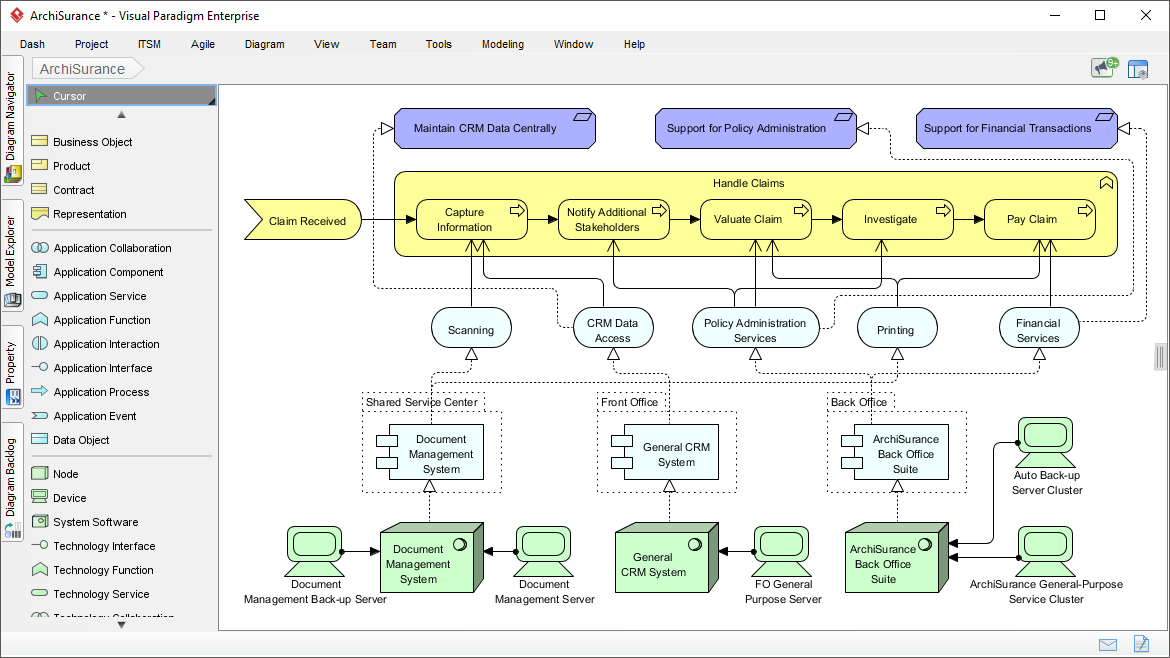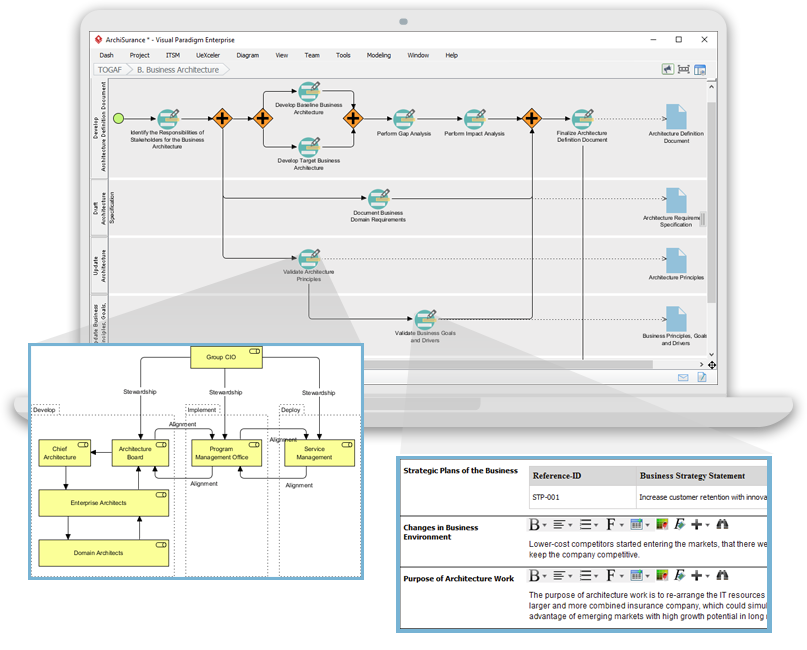Introduction
Enterprise architecture (EA) is a critical discipline that helps organizations align their business strategies with their IT infrastructure. Two prominent frameworks in this field are ArchiMate, a modeling language, and TOGAF (The Open Group Architecture Framework), which includes the Architecture Development Method (ADM). This article explores the standalone use of ArchiMate and its integration with TOGAF ADM, highlighting their complementary roles and benefits.
ArchiMate Standalone Use
What is ArchiMate?
ArchiMate is an open, independent enterprise architecture modeling language designed to describe, analyze, and visualize architecture across business domains with clarity and simplicity. It focuses on providing a standardized, concise set of concepts to model enterprise architecture layers—business, application, and technology—and their relationships.

Purpose and Benefits
Used standalone, ArchiMate enables architects to create clear visual models of enterprise architecture elements such as business processes, applications, and infrastructure without prescribing a specific development process. It is valued for its simplicity, ease of learning, and ability to represent complex architectures in an understandable way for diverse stakeholders.
Use Cases
Organizations may use ArchiMate independently when they want a robust modeling language to visualize and communicate architecture but do not require a formalized, step-by-step architecture development method. It is also useful for bridging different domains and integrating with other modeling languages like UML or BPMN.
ArchiMate Use with TOGAF ADM
TOGAF ADM Overview
TOGAF provides a comprehensive framework and a detailed Architecture Development Method (ADM) for developing enterprise architecture. ADM is a stepwise process guiding architects through phases such as Architecture Vision, Business Architecture, Information Systems Architecture, Technology Architecture, and implementation planning.

Complementary Roles
TOGAF ADM defines the process and methodology for architecture development, while ArchiMate provides the visual modeling language to represent the architecture artifacts produced during ADM phases. ArchiMate models help visualize and communicate the architecture clearly and consistently throughout the ADM cycle.
Integration Benefits
- Visualization and Communication: ArchiMate diagrams enhance stakeholder understanding by providing a shared, standardized visual language aligned with TOGAF’s architectural concepts.
- Structured Modeling: ArchiMate supports the creation of TOGAF ADM deliverables such as Architecture Vision, Business Architecture, and Technology Architecture views, enabling more intuitive and efficient modeling compared to traditional ADM artifacts.
- Seamless Mapping: ArchiMate elements and viewpoints can be mapped directly to ADM phases and artifacts, facilitating integration without losing the rigor of TOGAF’s structured approach.
- Tool Support: Many EA tools (e.g., Visual Paradigm) support combined use of TOGAF ADM and ArchiMate, providing guided processes and visual modeling capabilities to streamline architecture development.
Summary Comparison
| Aspect | ArchiMate Standalone | ArchiMate with TOGAF ADM |
|---|---|---|
| Nature | Modeling language only | Modeling language + structured development method |
| Focus | Visualizing and describing architecture | Visualizing architecture within ADM phases |
| Process Guidance | None (flexible use) | Step-by-step ADM process guidance |
| Artifacts Produced | ArchiMate models and views | ADM deliverables enhanced with ArchiMate diagrams |
| Stakeholder Communication | Visual clarity and standardization | Enhanced by ADM’s structured framework and ArchiMate’s visuals |
| Tool Support | Modeling tools supporting ArchiMate | Integrated tools supporting ADM + ArchiMate |
Conclusion
ArchiMate can be effectively used as a standalone enterprise architecture modeling language when the primary need is clear visualization and communication of architecture. However, its integration with TOGAF ADM provides a powerful combination where ArchiMate enriches the ADM process with precise, standardized visual models, improving clarity, consistency, and stakeholder engagement throughout the architecture development lifecycle. This complementary use is widely supported by tools and recognized as best practice in enterprise architecture.
Reference
- Visual Paradigm – ArchiMate: The Comprehensive Framework for Enterprise Architecture
- Visual Paradigm – Enhancing TOGAF ADM with ArchiMate: An Agile Visual Modeling Approach
- Visual Paradigm – TOGAF vs. ArchiMate: Can They Work Together?
- Visual Paradigm – Using ArchiMate with TOGAF ADM
- Visual Paradigm – Understanding the Purpose of ArchiMate: A Guide for Enterprise Architects
- Visual Paradigm – Using ArchiMate Tool with TOGAF ADM
- Visual Paradigm – Understanding the Differences Between ArchiMate and TOGAF: A Guide for Enterprise Architects
These resources provide comprehensive guides and tutorials on how to use the ArchiMate tool within Visual Paradigm, including its integration with TOGAF ADM.